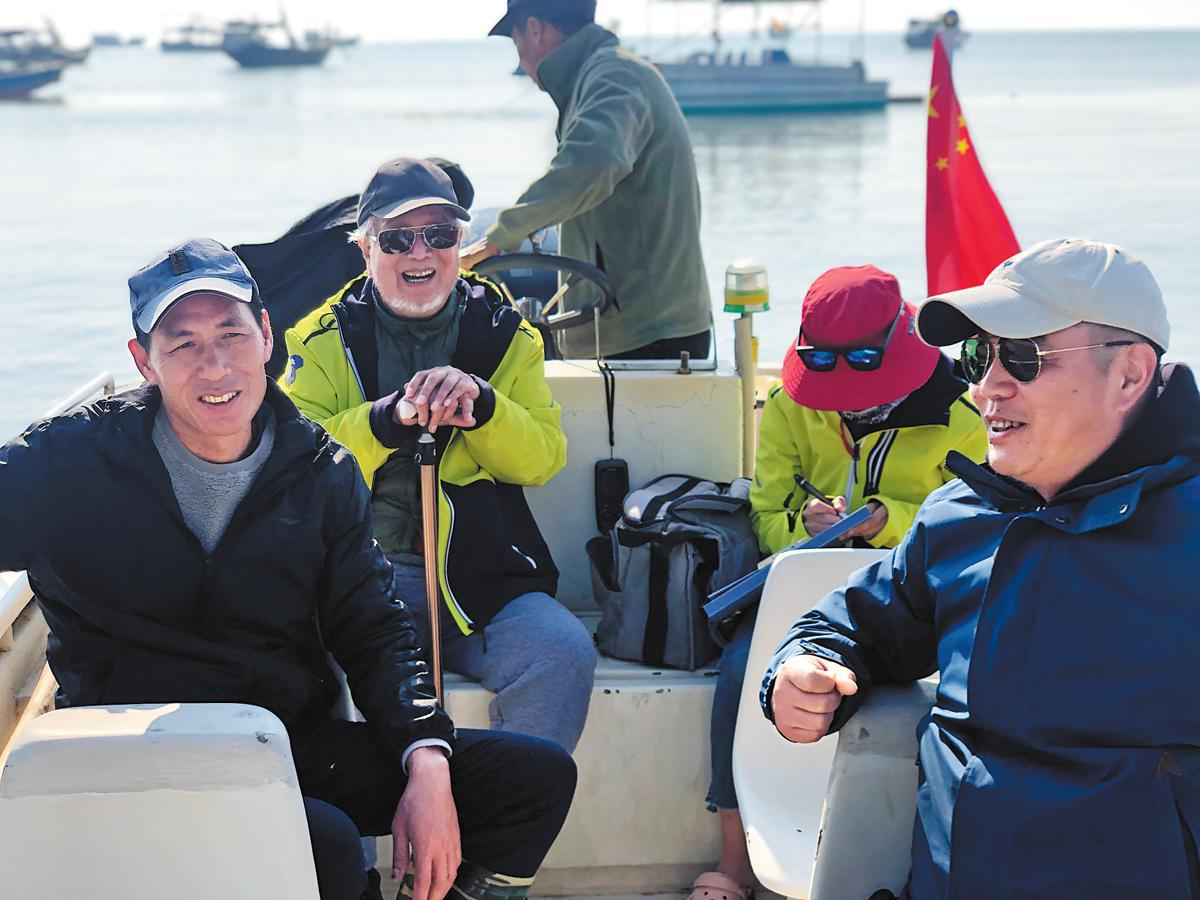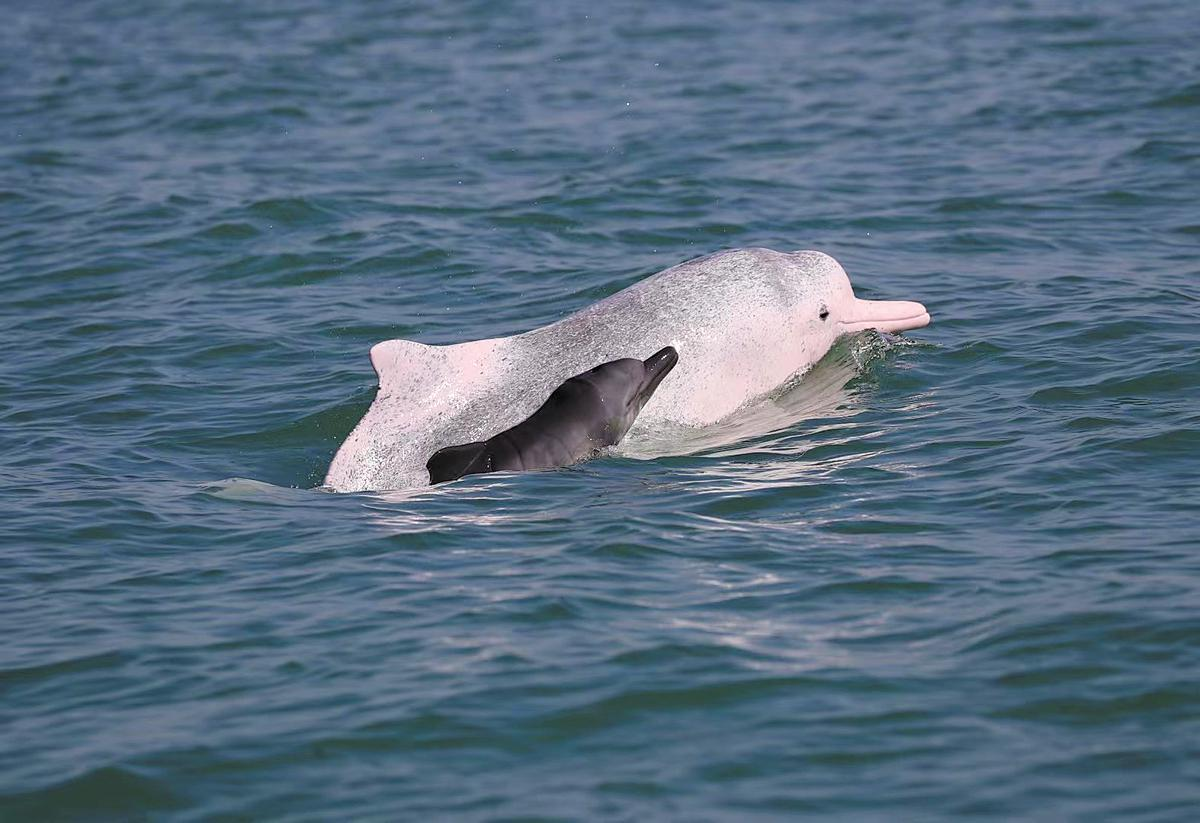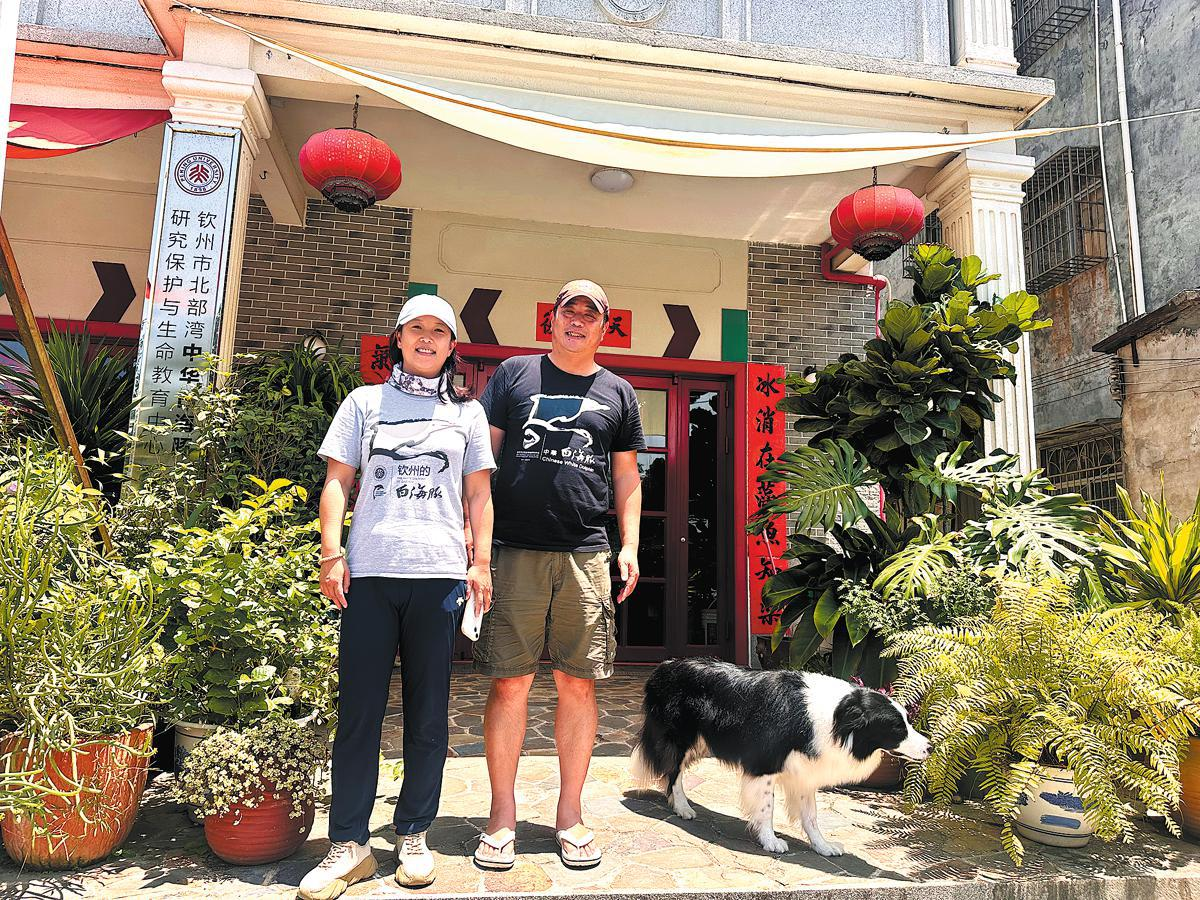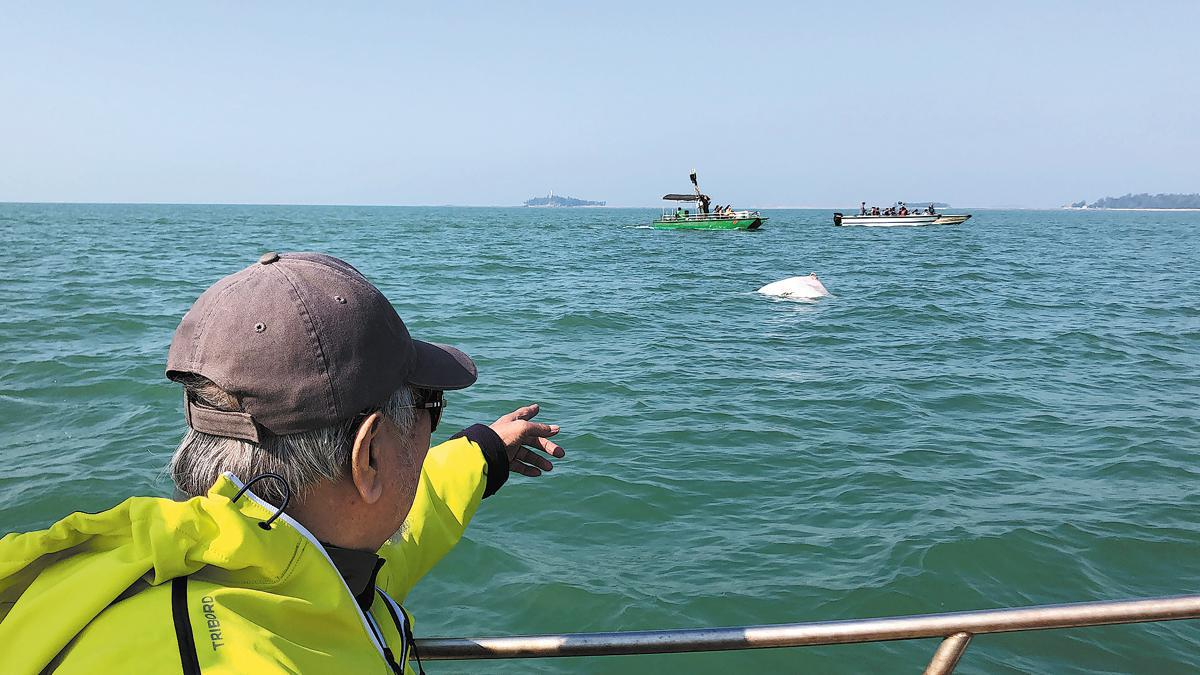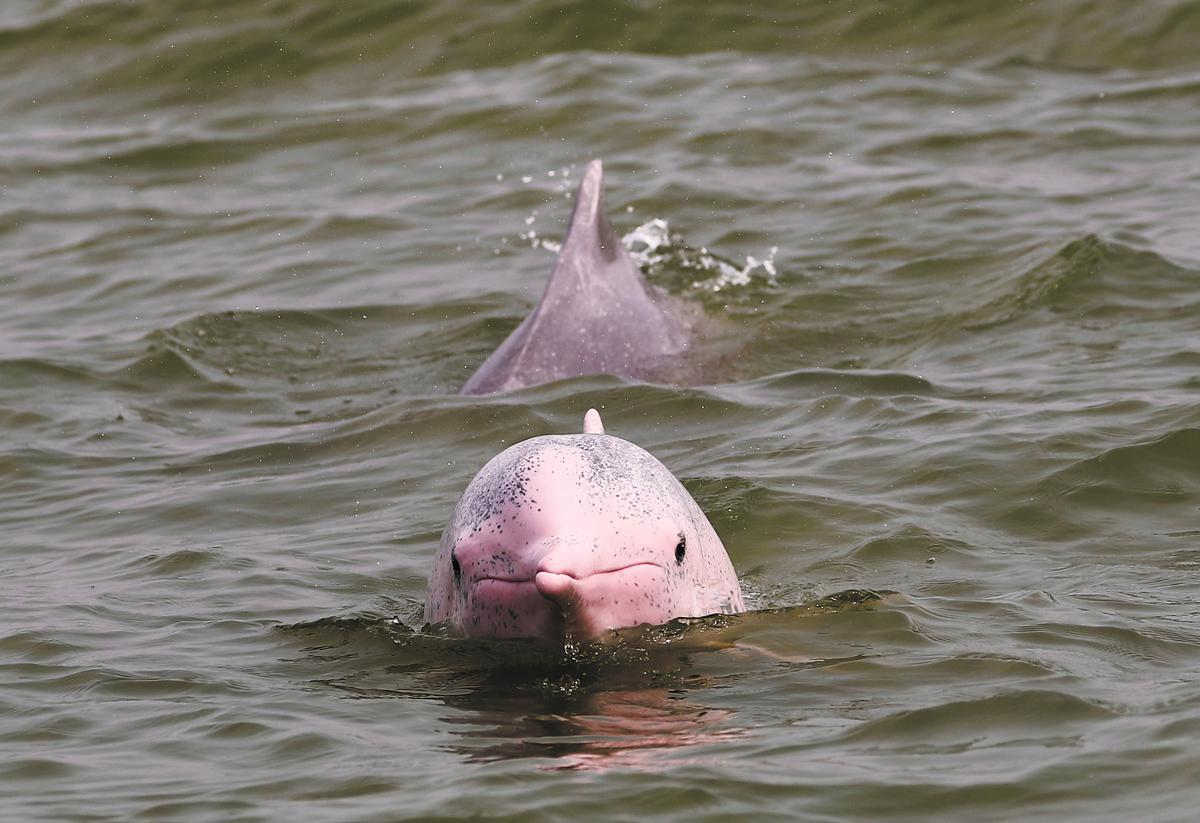Researchers led by Pan Wenshi look for Chinese white dolphins in Sanniang Bay off the coast of Qinzhou, Guangxi Zhuang autonomous region. CHINA DAILY
Protecting Chinese white dolphins has always been a family affair for Pan Yue. For almost two decades, Pan, her husband, and her father have taken nearly 5 million photographs documenting and studying the population of rare Chinese white dolphins in Sanniang Bay, Qinzhou, Guangxi Zhuang autonomous region.
Named for their overall white or light pink coloration in adulthood, Chinese white dolphins have an estimated population of no more than 5,000 individuals in the wild, distributed in the nearshore waters of Fujian and Guangdong provinces and Guangxi in South China. The first-class nationally protected wild animal is sometimes referred to as the "giant panda of the sea".
"White dolphins haven't received enough attention worldwide, nor have they been deeply researched. Many Westerners are still unaware of the existence of this species," said Pan, who, after graduating from Peking University in Beijing, moved to Qinzhou with her father in 2005 to research and protect the dolphins.
"Our understanding of the white dolphins is based on years of observation," she said.
Along the shores of Sanniang Bay live villagers who have relied on fishing for generations. Twenty years ago, villagers told Pan Yue's father, Pan Wenshi, about the presence of a white dolphin in the area.
Researchers depart for a science research trip from Qinzhou. CHINA DAILY
Pan Wenshi, a renowned biologist and professor at Peking University's School of Life Sciences, has been dedicated to the conservation of precious wildlife such as giant pandas and white-headed langurs since the 1980s.
Guided by the villagers, Pan Wenshi observed the white dolphins in Sanniang Bay. It was this that led him and his family to move to the area permanently in 2005 to begin efforts to protect the white dolphins.
"That year, my father saw a severely injured young dolphin that must have previously been entangled with fishing nets and whose body was injured and scarred. When he later discovered the dolphin had survived the ordeal, he named it Qinqin, with the first character of the name representing the city Qinzhou," Pan Yue said.
The survival rate for young dolphins is less than 50 percent, she said, with most dying due to factors such as congenital developmental issues and natural disasters.
Typically, out of 10 newborn dolphins, only three or four survive.
What is truly inspiring is that Qinqin, despite her severe injuries, not only survived but also gave birth to three calves over the next 20 years. When Pan Yue and her husband Zhao Yi go out to sea, Qinqin and her family members often frolic around their boat.
As they learn more about white dolphins, the villagers of Sanniang Bay have grown fonder of their long-standing neighbors.
Over the past 20 years, the Qinzhou government has designated white dolphins as a representative species for ecological protection, advocating a policy of the safe "coexistence of white dolphins with industry". This approach ensures the protection of the dolphins' living space amid urban development.
On the western side of Sanniang Bay, Qinzhou built Sandun Road which stretches into the sea for over 10 kilometers, showcasing the city's determination to protect the white dolphins. The barrier allows the dolphins to have a safer, cleaner and undisturbed habitat.
"If you stand at the end of Sandun Road and look westward, you'll see a large industrial area and port, with automated container operations, pipelines and more. For those who love this city, it's very astonishing to see the changes in Qinzhou Port over the past decade, and the economic development is encouraging," Zhao said.
"Looking eastward, however, you'll see a very quiet sea area. Beneath the calm surface, various forms of marine life, including Chinese white dolphins, inhabit the waters. This area represents Qinzhou's commitment to protecting the ecosystem and the freedom of survival for the local marine life.
"The true separation of industrial pollution and ecological protection is not just a road but a mindset. The ecological bottom line represented by Sandun Road has preserved a clean environment for the white dolphins and other local marine life," Zhao said.
Pan Yue and her husband Zhao Yi. CHINA DAILY
"The world is exploring how economic development and environmental protection can achieve a win-win situation because the two inherently conflict. The balance must be found in between," he said, adding that industrial development can bring rapid profits but also quickly impact the environment, whereas ecological protection requires a long-term commitment to see results.
"The population of white dolphins in Sanniang Bay has increased from fewer than 100 in 2005 to over 300, with an adequate number of female dolphins of reproductive age. Every year, three to eight dolphin calves are born and survive, forming a healthy natural population capable of breeding for generations," Pan Yue said.
Due to human activities dividing the habitats of white dolphins into small segments, the populations couldn't continue gene exchanges between groups, affecting the breeding of future generations.
"For example, in Hong Kong and Zhuhai, Guangdong, where economic development occurred earlier, urban construction impacted the surrounding white dolphin populations, putting them at risk of extinction," Zhao explained.
Pan Wenshi points to a dolphin in Sanniang Bay. CHINA DAILY
"The white dolphin population in Sanniang Bay is likely the only healthy one. As long as there is a certain level of gene exchange with populations in Guangdong, in a few decades, the number could increase to 500, the peak capacity this area can support," he said.
"Every life form has taken millions of years to evolve. While many things can be re-created if lost, once a species disappears from the planet, it can never be re-created."
The couple believes that only by protecting a species can the research conducted on it be meaningful. They refer to their approach to observing and protecting the white dolphins as "conservation biology".
Today, the house where the Pan family resides has been designated as the Life Education and Chinese White Dolphin Research Conservation Center of Qinzhou Beibu Gulf. Upon entering, a wall-sized map of Sanniang Bay clearly marks the activity area of the Chinese white dolphins. During summer and winter vacations, Pan Yue's family arranges for students from across the country to visit Sanniang Bay for educational tours to learn about the white dolphins and cultivate positive attitudes toward protecting wildlife.
The village government has also organized sea excursions for visitors, not only increasing local incomes, but also raising awareness about this special neighbor.
Source:
China Daily
Written by:
Yan Dongjie and Shi Ruipeng

